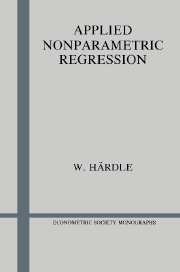Book contents
- Frontmatter
- PART I Regression smoothing
- PART II The kernel method
- 4 How close is the smooth to the true curve?
- 5 Choosing the smoothing parameter
- 6 Data sets with outliers
- 7 Nonparametric regression techniques for correlated data
- 8 Looking for special features and qualitative smoothing
- 9 Incorporating parametric components
- PART III Smoothing in high dimensions
- Appendix 1
- Appendix 2
- References
- Name Index
- Subject Index
8 - Looking for special features and qualitative smoothing
from PART II - The kernel method
Published online by Cambridge University Press: 05 January 2013
- Frontmatter
- PART I Regression smoothing
- PART II The kernel method
- 4 How close is the smooth to the true curve?
- 5 Choosing the smoothing parameter
- 6 Data sets with outliers
- 7 Nonparametric regression techniques for correlated data
- 8 Looking for special features and qualitative smoothing
- 9 Incorporating parametric components
- PART III Smoothing in high dimensions
- Appendix 1
- Appendix 2
- References
- Name Index
- Subject Index
Summary
Many economists uncritically accept the appropriateness of a functional form on the basis of convention or convenience; others try several forms for their relations but report only the one that in some sense “looks best” a posteriori.
C. Hildreth (1954, p. 600)One is often interested not only in the curve itself but also in special qualitative characteristics of the smooth. The regression function may be constrained to simple shape characteristics, for example, and the smooth should preferably have the same qualitative characteristics. A quite common shape characteristic is a monotonic or unimodal relationship between the predictor variable and the response variable. This a priori knowledge about the qualitative form of the curve should be built into the estimation technique. Such qualitative features do not necessarily lead to better rates of convergence but help the experimenter in interpretation of the obtained curves.
In economic applications involving demand, supply and price, functions with prescribed shape (monotonicity, convexity, etc.) are common. Lipsey, Sparks and Steiner (1976, chapter 5) present a number of convex decreasing demand curves and convex increasing supply curves (in both cases, price as a function of quality). They also give an example for quantity demanded as a function of household income. A more complex procedure could be applied to the potato Engel curve in Figure 1.2. The nonparametric fit shows a partially increasing and a decreasing segment. This curve could be estimated by a unimodal regression technique.
- Type
- Chapter
- Information
- Applied Nonparametric Regression , pp. 217 - 231Publisher: Cambridge University PressPrint publication year: 1990



